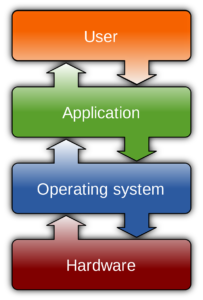Functions of Operating Systems
An operating system (OS) is a program that acts as an interface
between the system hardware and the user. Moreover, it handles all the
interactions between the software and the hardware. All the working of a computer system depends on the OS at the base level.
Further, it performs all the functions like handling memory,
processes, the interaction between hardware and software, etc. Now, let us look
at the objectives of the operating system.
{tocify} $title= {Table
of Contents}
 |
| An Operating Systems |
An operating system is a program that
acts as a user-computer GUI (Graphical user interface). It controls the
execution of all types of applications.
The operating system performs the following functions in a device.
- Instruction
- Input/output Management
- Memory Management
- File Management
- Processor Management
- Job Priority
- Special Control Program
- Scheduling of resources and jobs
- Security
- Monitoring activities
- Job accounting
Instruction: The operating system establishes a mutual understanding
between the various instructions given by the user.
Input/output Management: What output will come from the input
given by the user, the operating system runs this program. This management
involves coordinating various input and output devices. It assigns the
functions of those devices where one or more applications are executed.
Memory Management: The operating system handles the
responsibility of storing any data, system programs, and user programs in
memory. This function of the operating system is called memory management.
File Management: The operating system is helpful in
making changes in the stored files and in replacing them. It also plays an
important role in transferring various files to a device.
Processor Management: The processor is the execution of a
program that accomplishes the specified work in that program. It can be defined
as an execution unit where a program runs.
Job Priority: The work of job priority is creation and
promotion. It determines what action should be done first in a computer system.
Special Control Program: The operating systems make automatic
changes to the task through specific control programs. These programs are
called Special Control Program.
Scheduling of resources and jobs: The operating system prepares the list
of tasks to be performed for the device of the computer system. The operating system decides which device to use for which
task. This action becomes complicated when multiple tasks are to be performed
simultaneously in a computer system. The scheduling programs of the operating
system determine the order in which tasks are completed. It performs these
tasks based on the priority of performing the tasks given by the user. It makes
the tasks available based on the priority of the device.
Security: Computer security is a very important
aspect of any operating system. The reliability of an operating system is
determined by how much better security it provides us. Modern operating systems
use a firewall for security. A firewall is a security system that monitors
every activity happening in the computer and blocks that activity in case of
any threat.
Monitoring activities: The operating system takes care of the
activities of the computer system during various processes. This aborts the
program if there are errors. The operating system sends instant messages to the
user for any unexpected error in the input/output device. It also provides
security to the system when the operating system is used in systems operated by
multiple users. So that illegal users cannot get data from the system.
Job accounting: It keeps track of time & resources used by
various jobs and users.
Objectives of OS
The primary goals of an operating system are as follows:
·
Convenience – An operating system improves the
use of a machine. Operating systems enable users to get started on the things
they wish to complete quickly without having to cope with the stress of first
configuring the system.
·
Efficiency – An operating system enables the
efficient use of resources. This is due to less time spent configuring the
system.
·
Ability to evolve – An operating system should be
designed in such a way that it allows for the effective development, testing,
and introduction of new features without interfering with service.
·
Management of system resources – It
guarantees that resources are shared fairly among various processes and users.
Functions of Operating System
 |
| Functions of the operating Systems |
It is the management of the main or primary memory. Whatever program is
executed, it has to be present in the main memory. Main memory is a quick
storage area that may be accessed directly by the CPU. When the program is
completed, the memory region is released and can be used by other programs.
Therefore, there can be more than one program present at a time. Hence, it is
required to manage the memory. The operating system: ·
Allocates and deallocates the memory. ·
Keeps a record of which part of primary memory is used
by whom and how much. ·
Distributes the memory while multiprocessing. ·
In multiprogramming, the operating system selects which
processes acquire memory when and how much memory they get. 2. Processor Management/SchedulingEvery software that runs on a computer, whether in the
background or in the frontend, is a process. Processor management is an
execution unit in which a program operates. The operating system
determines the status of the processor and processes, selects a job and its processor,
allocates the processor to the process, and de-allocates the processor after
the process is completed. When more than one process runs on the system the OS
decides how and when a process will use the CPU. Hence, the name is also CPU Scheduling. The OS: ·
Allocates and
deallocates processor to the processes. ·
Keeps record of CPU
status. Certain algorithms used for CPU scheduling are as
follows: ·
First Come First Serve
(FCFS) ·
Shortest Job First (SJF) · Round-Robin Scheduling · Priority-based scheduling etc.
|
